engine coolant RENAULT ESPACE 2000 J66 / 3.G Technical Note 3426A Workshop Manual
[x] Cancel search | Manufacturer: RENAULT, Model Year: 2000, Model line: ESPACE, Model: RENAULT ESPACE 2000 J66 / 3.GPages: 52, PDF Size: 0.98 MB
Page 2 of 52

Downloaded from www.Manualslib.com manuals search engine Contents
Page
07
10
11
12
16
VALUES AND SETTINGS
Capacities - Grades 07-1
Tightening the cylinder head 07-2
ENGINE AND PERIPHERALS
Identification 10-1
Oil pressure 10-2
Engine and transmission assembly 10-3
TOP AND FRONT OF ENGINE
Accessories belt 11-1
Timing belt 11-2
Cylinder head gasket 11-8
TURBOCHARGING - FUEL
MIXTURE
Turbocharger 12-1
Air inlet 12-3
Exhaust manifold 12-7
Inlet manifold 12-8
STARTING - CHARGING
Alternator 16-1
Starter 16-4Page
19
21
61
62
COOLING SYSTEM
Filling - bleeding 19-1
Diagram 19-2
Coolant pump 19-3
Suspended mountings 19-4
Cooling system 19-5
MANUAL GEARBOX
Identification 21-1
Gears 21-2
Lubricants 21-3
Remove and refit 21-4
HEATING
Additional heating 61-1
AIR CONDITIONING
Air conditioning compressor 62-1
Page 3 of 52
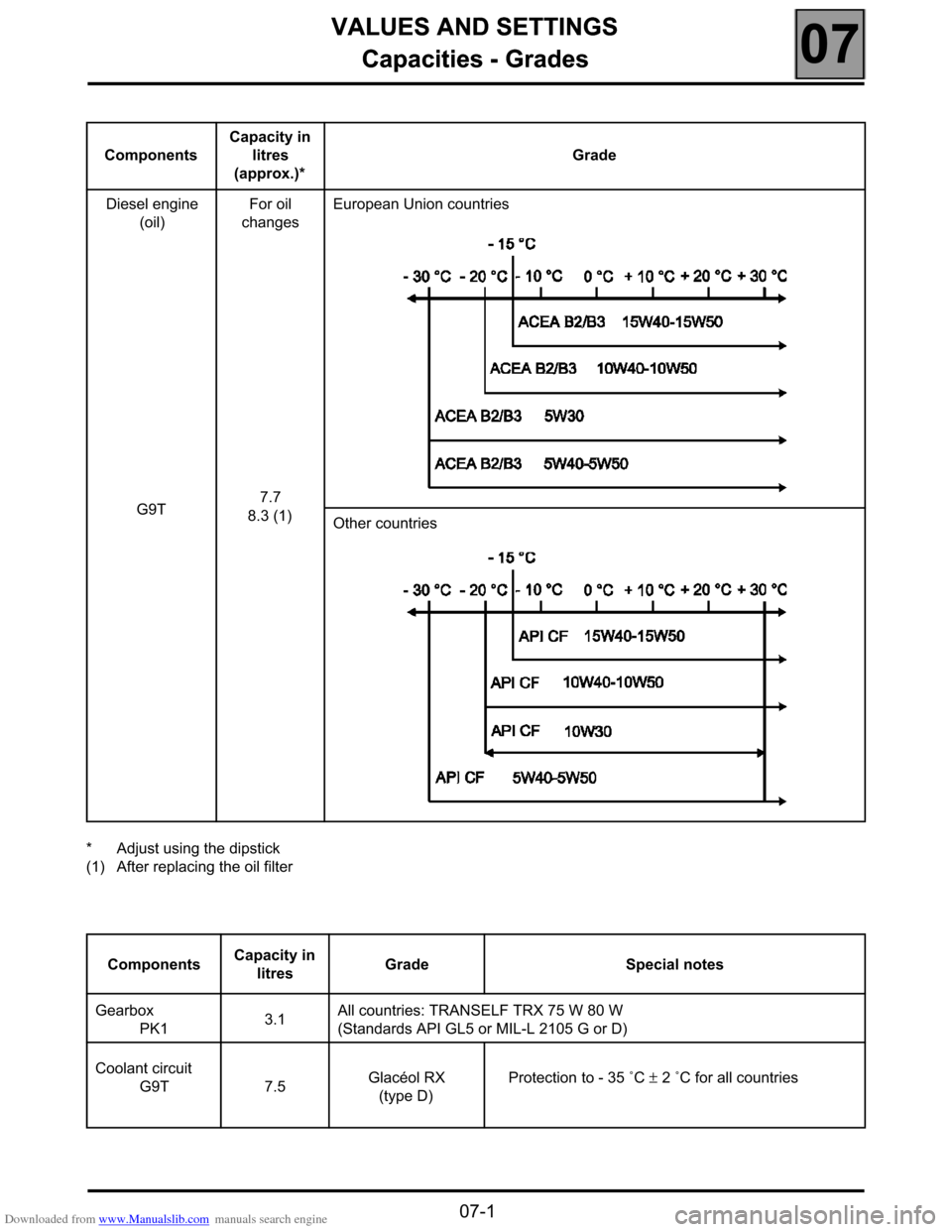
Downloaded from www.Manualslib.com manuals search engine VALUES AND SETTINGS
Capacities - Grades
07
107VALUES AND SETTINGS
Capacities - Grades
* Adjust using the dipstick
(1) After replacing the oil filterComponentsCapacity in
litres
(approx.)*Grade
Diesel engine
(oil)
G9TFor oil
changes
7.7
8.3 (1)European Union countries
Other countries
ComponentsCapacity in
litresGrade Special notes
Gearbox
PK13.1All countries: TRANSELF TRX 75 W 80 W
(Standards API GL5 or MIL-L 2105 G or D)
Coolant circuit
G9T 7.5Glacéol RX
(type D)Protection to - 35 ˚C ± 2 ˚C for all countries
07-1
Page 37 of 52

Downloaded from www.Manualslib.com manuals search engine COOLING SYSTEM
Filling and bleeding
19
119COOLING SYSTEM
Filling and bleeding
There is continuous circulation in the heater matrices.
FILLING
It is essential to open the two bleed screws at the
top of the radiator and the cylinder head coolant
pipe housing outlet.
Fill the circuit through the expansion bottle opening.
Close the bleed screws as soon as the liquid starts to
flow in a continuous stream.
Start the engine (2 500 rpm).
Adjust the level by overflow for a period of about
4 minutes.
Close the bottle.
BLEEDING
Allow the engine to run for about 20 minutes at
2 500 rpm, until the engine fans(s) operate (time
necessary for automatic degassing).
Check the liquid level is at the "Maximum" marker.
DO NOT OPEN THE BLEED SCREWS WHILST THE
ENGINE IS RUNNING.
REFIT THE EXPANSION BOTTLE CAP WHILE THE
ENGINE IS WARM.
19-1
Page 38 of 52

Downloaded from www.Manualslib.com manuals search engine COOLING SYSTEM
Diagram
19
19-2
Diagram
SPECIFIC COOLANT CIRCUIT
1Engine
2Radiator
3"Hot" tank with degassing after thermostat
4Heater matrix
5Thermostat mounting
6Thermoplunger mounting
7Coolant pump
8Bleed screw
9Temperature switch
10 Heater (if fitted)
11 Oil cooler + "eco" oil filter
The expansion bottle valve rating is 1.2 bar (colour: brown).
Page 39 of 52
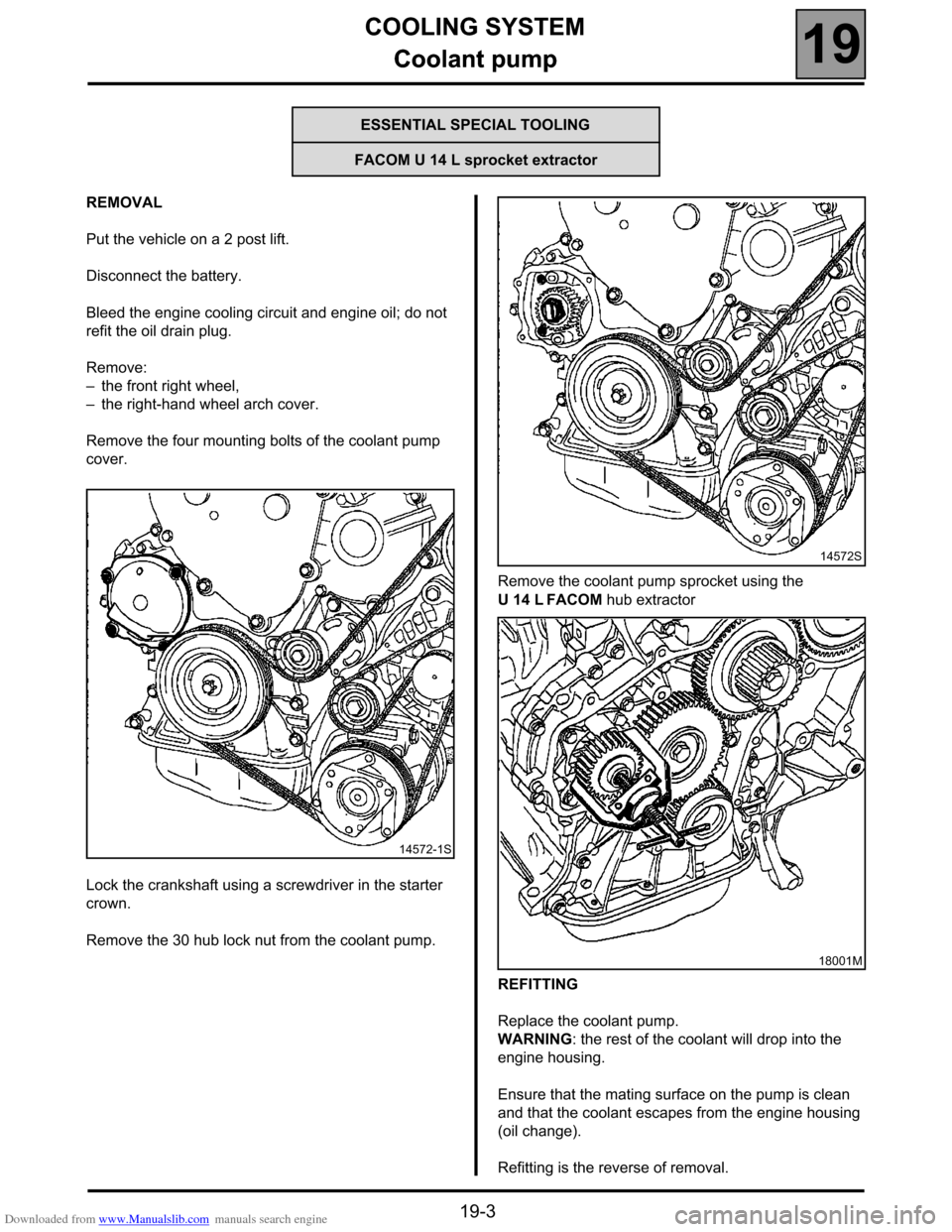
Downloaded from www.Manualslib.com manuals search engine COOLING SYSTEM
Coolant pump
19
19-3
Coolant pump
REMOVAL
Put the vehicle on a 2 post lift.
Disconnect the battery.
Bleed the engine cooling circuit and engine oil; do not
refit the oil drain plug.
Remove:
–the front right wheel,
–the right-hand wheel arch cover.
Remove the four mounting bolts of the coolant pump
cover.
Lock the crankshaft using a screwdriver in the starter
crown.
Remove the 30 hub lock nut from the coolant pump.Remove the coolant pump sprocket using the
U 14 L FACOM hub extractor
REFITTING
Replace the coolant pump.
WARNING: the rest of the coolant will drop into the
engine housing.
Ensure that the mating surface on the pump is clean
and that the coolant escapes from the engine housing
(oil change).
Refitting is the reverse of removal.
ESSENTIAL SPECIAL TOOLING
FACOM U 14 L sprocket extractor
14572-1S
14572S
18001M
Page 41 of 52
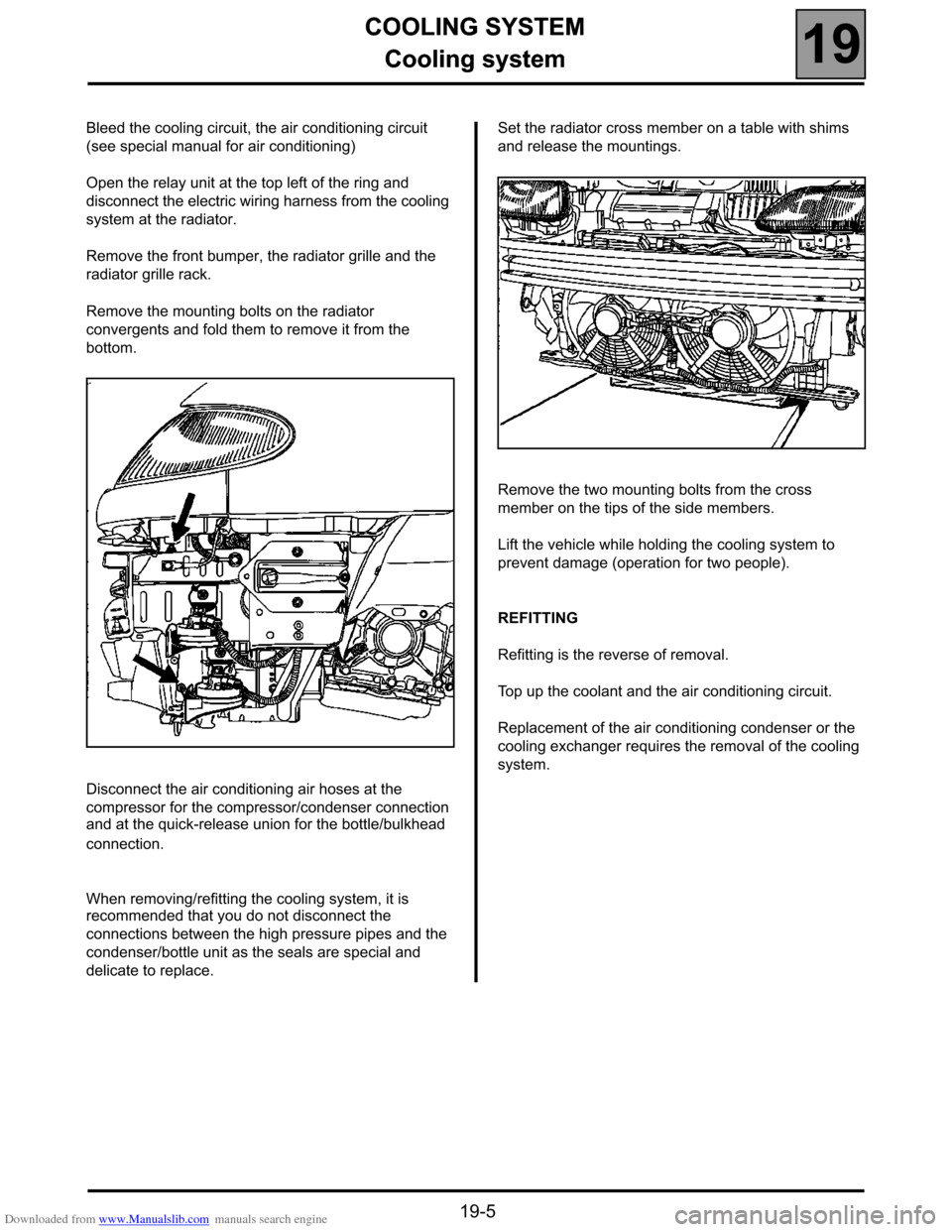
Downloaded from www.Manualslib.com manuals search engine COOLING SYSTEM
Cooling system
19
19-5
COOLING SYSTEM
Cooling system
Bleed the cooling circuit, the air conditioning circuit
(see special manual for air conditioning)
Open the relay unit at the top left of the ring and
disconnect the electric wiring harness from the cooling
system at the radiator.
Remove the front bumper, the radiator grille and the
radiator grille rack.
Remove the mounting bolts on the radiator
convergents and fold them to remove it from the
bottom.
Disconnect the air conditioning air hoses at the
compressor for the compressor/condenser connection
and at the quick-release union for the bottle/bulkhead
connection.
When removing/refitting the cooling system, it is
recommended that you do not disconnect the
connections between the high pressure pipes and the
condenser/bottle unit as the seals are special and
delicate to replace.Set the radiator cross member on a table with shims
and release the mountings.
Remove the two mounting bolts from the cross
member on the tips of the side members.
Lift the vehicle while holding the cooling system to
prevent damage (operation for two people).
REFITTING
Refitting is the reverse of removal.
Top up the coolant and the air conditioning circuit.
Replacement of the air conditioning condenser or the
cooling exchanger requires the removal of the cooling
system.
Page 46 of 52
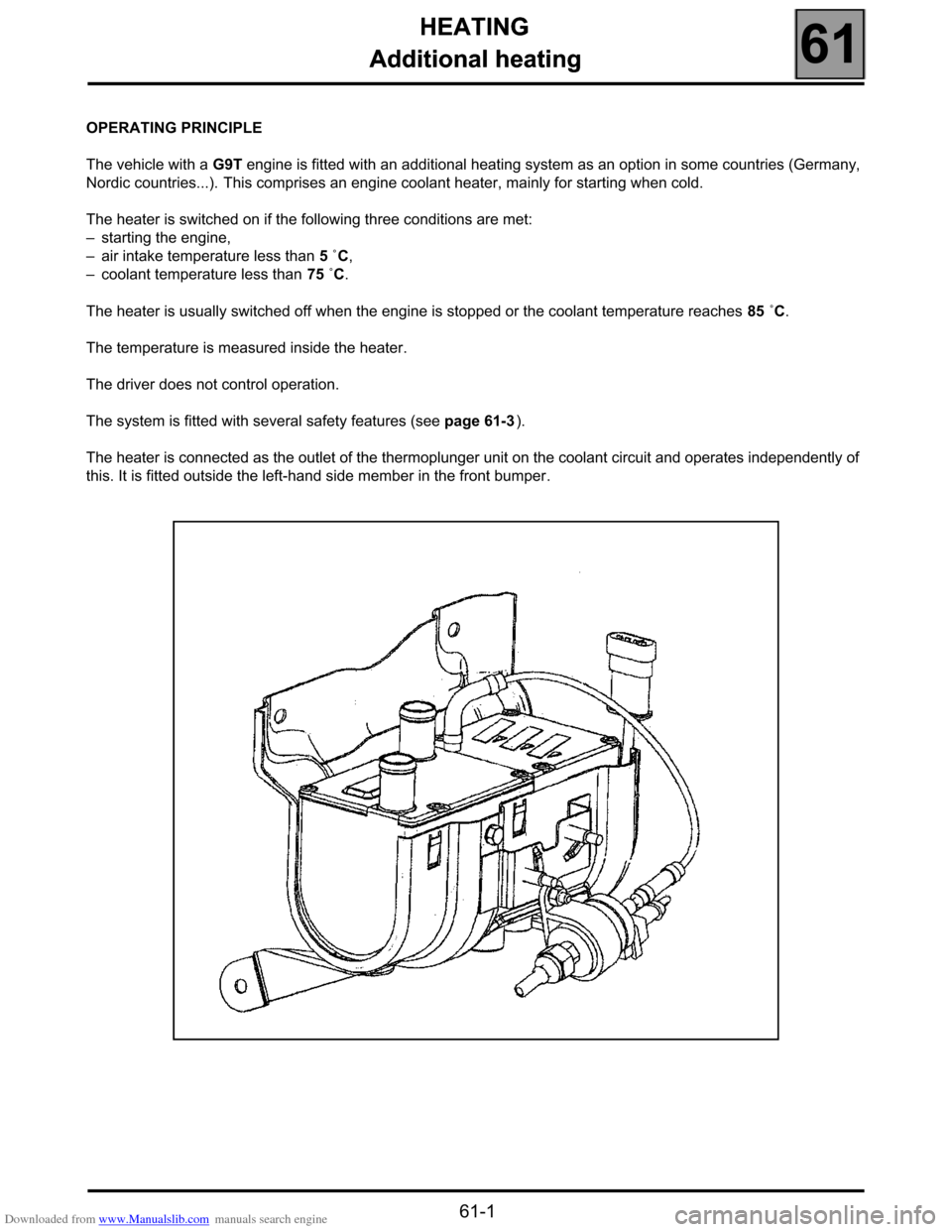
Downloaded from www.Manualslib.com manuals search engine HEATING
Additional heating
61
161HEATING
Additional heating
OPERATING PRINCIPLE
The vehicle with a G9T engine is fitted with an additional heating system as an option in some countries (Germany,
Nordic countries...). This comprises an engine coolant heater, mainly for starting when cold.
The heater is switched on if the following three conditions are met:
–starting the engine,
–air intake temperature less than 5 ˚C,
–coolant temperature less than 75 ˚C.
The heater is usually switched off when the engine is stopped or the coolant temperature reaches 85 ˚C.
The temperature is measured inside the heater.
The driver does not control operation.
The system is fitted with several safety features (see page 61-3).
The heater is connected as the outlet of the thermoplunger unit on the coolant circuit and operates independently of
this. It is fitted outside the left-hand side member in the front bumper.
61-1
Page 47 of 52
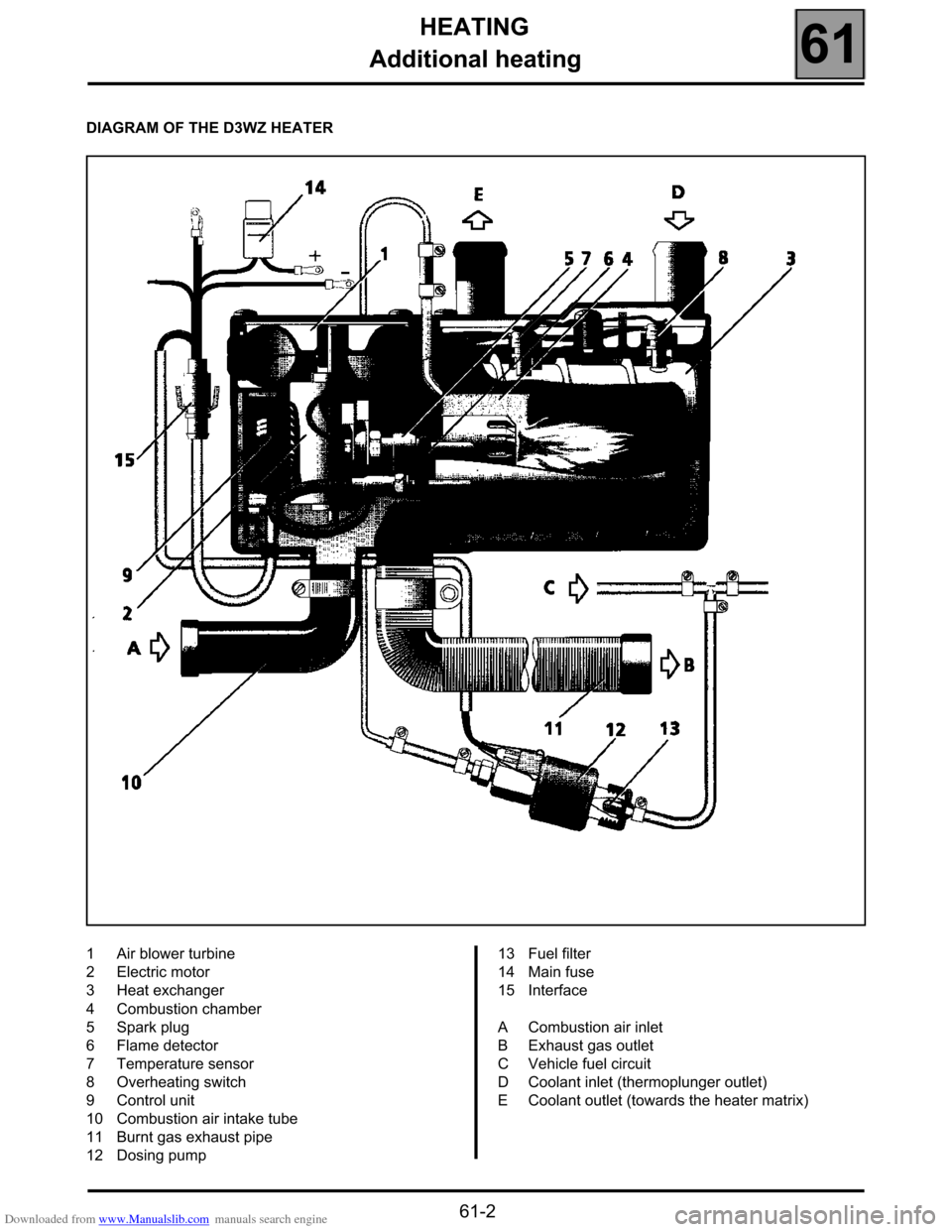
Downloaded from www.Manualslib.com manuals search engine HEATING
Additional heating
61
61-2
DIAGRAM OF THE D3WZ HEATER
1Air blower turbine
2Electric motor
3Heat exchanger
4Combustion chamber
5Spark plug
6Flame detector
7Temperature sensor
8Overheating switch
9Control unit
10 Combustion air intake tube
11 Burnt gas exhaust pipe
12 Dosing pump 13 Fuel filter
14 Main fuse
15 Interface
ACombustion air inlet
BExhaust gas outlet
CVehicle fuel circuit
DCoolant inlet (thermoplunger outlet)
ECoolant outlet (towards the heater matrix)
Page 48 of 52

Downloaded from www.Manualslib.com manuals search engine HEATING
Additional heating
61
61-3
TECHNICAL SPECIFICATIONS
The heater is fitted with an igniter appropriate for the
vehicle fuel.
It operates in two power levels:
–1˚) Low speed:
●Power: 1600 Watts,
●Fuel consumption: 0.2 l/hour.
–2˚) High speed:
●Power: 3300 Watts.
●Fuel consumption: 0.4 l/hour.
When the engine is started, the heater is operated at
high speed; circulation of the coolant inside the
exchanger is ensured by the vehicle coolant circuit.
A Temperature (˚C)
B Minutes
–Range a:
High speed.
–Range b:
Low speed.
–Range c:
Heater stop.
Coolant temperature measured inside the heater.SAFETY SYSTEMS
The system is fitted with several safety features; it cuts
out:
–if the difference in coolant temperature read by the
two internal heater sensors reaches 15 ˚C,
–if the coolant temperature reaches 120 ˚C (different
safety features than reading 85˚),
–if the flame detector does not detect combustion,
(notably the heater fuel pump),
–if the battery voltage is greater than 16 volts or less
than 10 volts.
Other safety devices:
–when the heater does not light 90 seconds after the
supply of fuel is started, the starting procedure is
repeated. If, during the following 90 seconds the
system still does not start, the emergency stop is
engaged.
–if the flame extinguishes during operation the starting
procedure is repeated. If the heater does not start up
in the following 90 seconds, the emergency stop is
engaged.
–in the event of overheating (lack of coolant,
incorrectly drained cooling circuit...), the overheating
switch reacts, the fuel supply is stopped and the
emergency stop is engaged. The heater can be
restarted after the source of overheating has been
eliminated and the heater has cooled sufficiently.
SWITCHING OFF
To temporarily disconnect the heater (operation with
engine running in an enclosed space, noises when
cold,...), disconnect the connector (15) (page 61-2).
If possible, check that the heater engages after it is
reconnected.
The main F49 (70 A) fuse on the engine
intercommunication unit supplies the additional
heating system.
Page 49 of 52
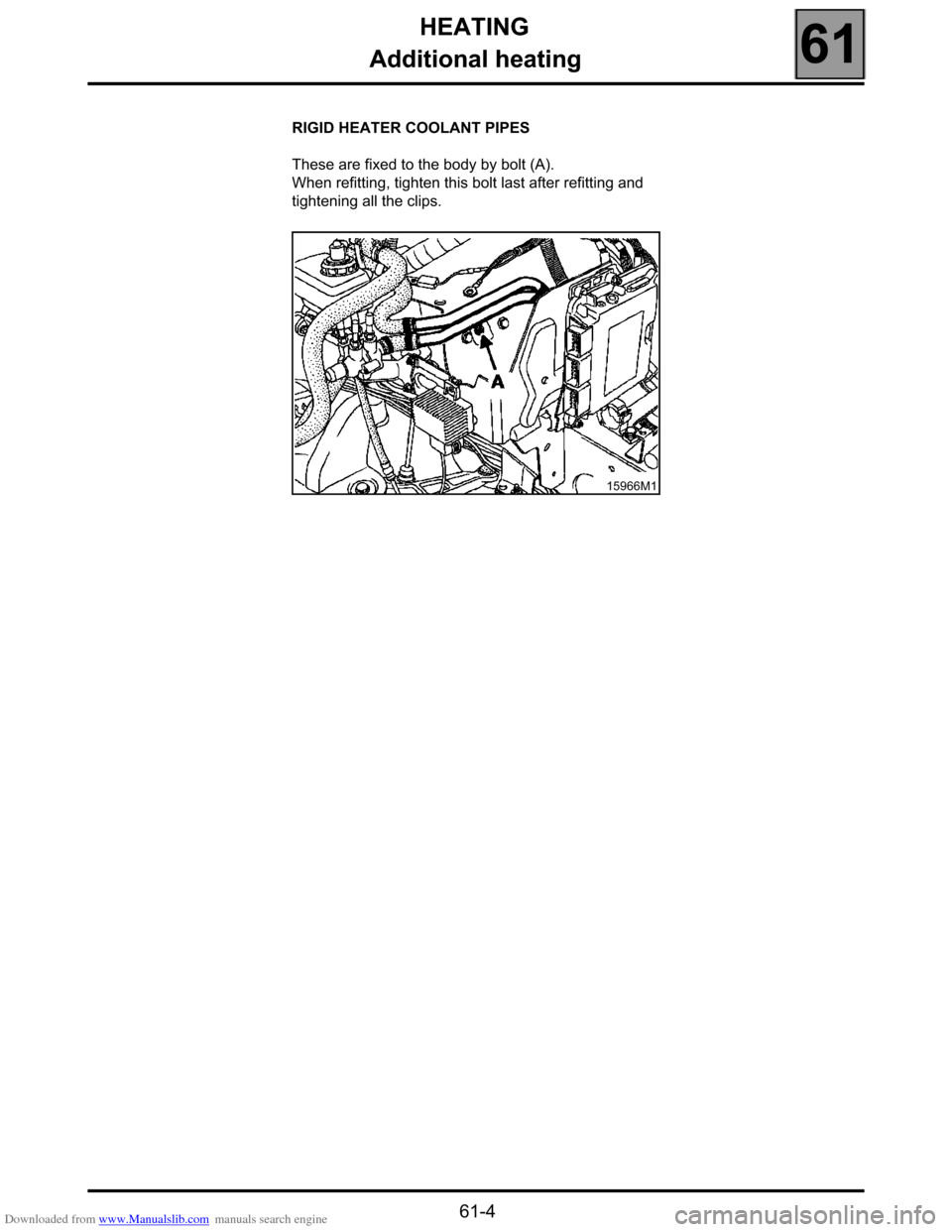
Downloaded from www.Manualslib.com manuals search engine HEATING
Additional heating
61
61-4
RIGID HEATER COOLANT PIPES
These are fixed to the body by bolt (A).
When refitting, tighten this bolt last after refitting and
tightening all the clips.
15966M1